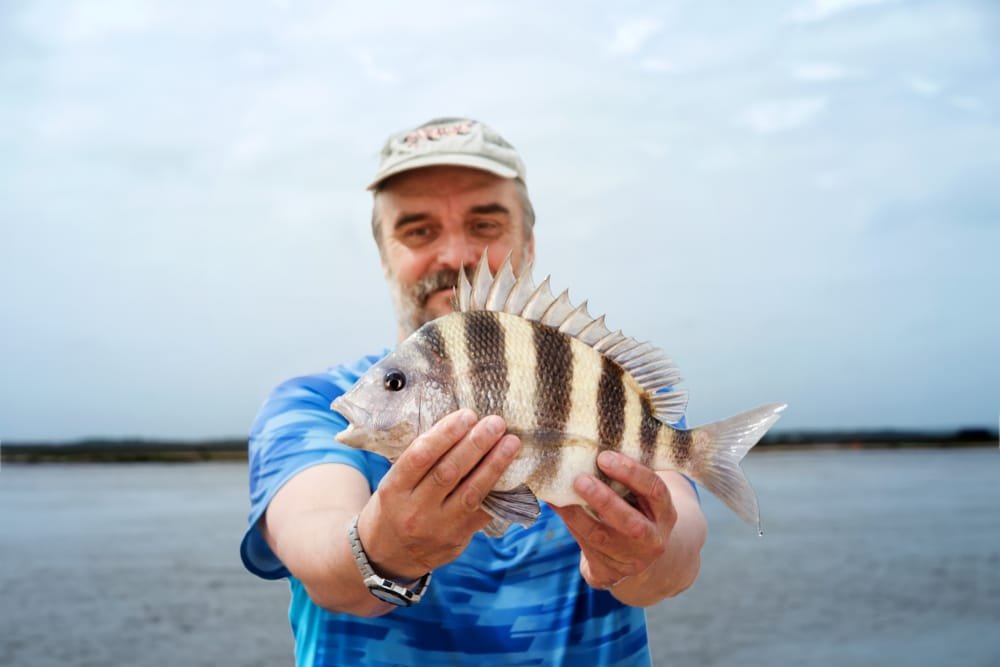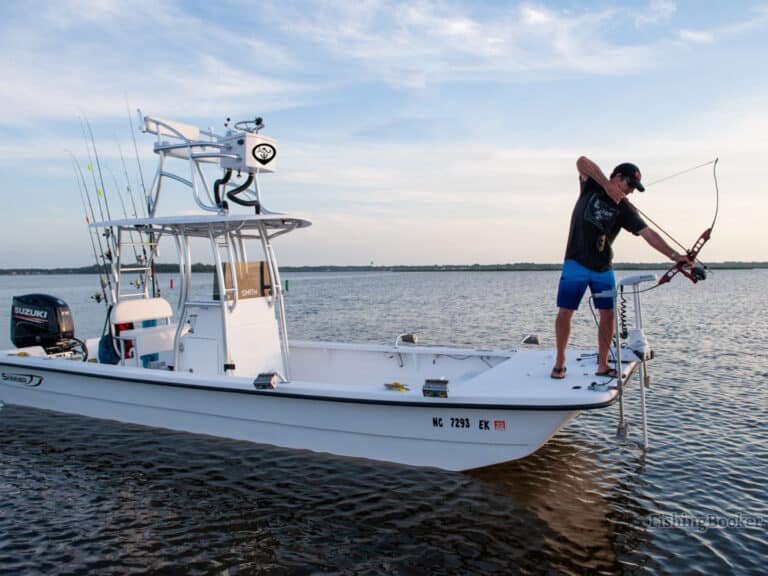Bow Fishing Texas: A Thrilling Aquatic Adventure Since 1789
In recent years, bow fishing has gained immense popularity among outdoor enthusiasts in the Lone Star State. Bow Fishing Texas offers vast water bodies teeming with diverse species of fish, making it the perfect haven.

When it comes to bow fishing, having the right equipment is crucial for a successful and enjoyable experience. Let’s start with the most essential piece: the bow. You’ll want to select a bow designed for bow fishing, as it differs from traditional archery bows.
These bows are typically shorter and have heavier draw weights, usually 30 to 50 pounds. Opting for a heavier draw weight ensures that your arrow has enough power to penetrate the water and secure your catch.
Reel options: hand-wrap reels, retriever reels, etc.
Choosing the right reel is another important consideration in bow fishing. Various options are available, each with its advantages.
Hand-wrap reels are simple and cost-effective; they require manually wrapping the line around a spool before shooting. On the other hand, retriever reels offer easy line retrieval by utilizing a push-button mechanism that automatically winds the line back into the reel after shooting.
Arrows: types, tips, and retrieval systems
Selecting appropriate arrows is key in ensuring effective shots while bow fishing. Unlike arrows used in traditional archery, bow fishing arrows have barbed tips designed to impale fish upon impact and prevent them from escaping easily. Some common arrow types include fiberglass or carbon shafts with specialized broadheads or fish points for maximum effectiveness.
Also, retrieval systems play an important role in recovering your arrows and potential catches. Consider using reel-mounted retrievers that allow you to retrieve your arrow without getting tangled up underwater easily.
Safety measures while bow fishing
While enjoying this exciting activity out on Texas waters, it’s crucial to prioritize safety at all times. Familiarize yourself with local regulations and obtain any required permits before embarking on your bow fishing adventure.
These regulations may outline specific rules regarding allowed species, bag limits, and designated areas for bow fishing. Proper shooting angles and distances are important to ensure safety during the shoot.
Avoid taking shots too close or at extreme angles, as this can lwhicharrow deflection or ricochets. Maintaining a safe shooting distance protects your equipment and reduces the risk of accidental injuries.
Remember to protect yourself from potential hazards. Wear appropriate eye protection to shield your eyes from splashes and debris in the water.
Additionally, consider using gloves to protect your hands while handling fish and arrows. By adhering to these safety measures, you can enjoy the thrilling experience of bow fishing in Texas while minimizing any risks involved!
Target Species in Texas Waters for Bow Fishing

Freshwater Alligator Gar: Size, Behavior, and Best Locations
The alligator gar, known for its prehistoric appearance, is a sought-after species in bow fishing. These monstrous creatures can grow up to 10 feet long and weigh over 300 pounds.
Found in various Texas waterways such as the Trinity River and Lake Ray Roberts, alligator gar tend to inhabit slow-moving rivers, bayous, and oxbow lakes. They have a unique breathing method called “ganoid scales” to extract oxygen from the air.
During bow fishing expeditions, you’ll often spot these incredible creatures lurking near shallow areas with vegetation or structures like fallen trees. Remember that their size and strength make it vital to use appropriate gear and exercise caution when approaching an alligator gar.
Common Carp: Characteristics, Habitats, and Feeding Habits

The common carp is another popular target for bow fishing enthusiasts in Texas. These resilient fish can adapt to various environments but are commonly found in lakes such as Lake Texoma or the Trinity River. Carp are known for their impressive size; it’s not uncommon to encounter specimens weighing between 15 and 30 pounds!
They have an omnivorous diet that includes crustaceans, insects, plants, and small fish. When bow fishing for carp, look for shallow areas with murky water since they prefer rooting around the muddy bottom, searching for food.
Buffalo Fish: Identification Tips and Preferred Environments

The buffalo fish group comprises several species commonly found in Texas waters, such as the Bigmouth and Smallmouth Buffalo. They are characterized by their sturdy build, deep, broad bodies, and distinctive sucker-like mouths.
These fish prefer gravel or sandy bottom areas in rivers and lakes such as the Sabine River Basin.
Buffalo fish are primarily herbivores, feeding on aquatic vegetation like water lilies and submerged grasses. When targeting buffalo fish during bow fishing expeditions, keep an eye out for schools of these creatures in deeper waters with good visibility.
Saltwater Spotted Seatrout: Behavior Patterns

The spotted seatrout, known as speckled trout or specks, are highly sought-after saltwater species for bow fishing along the Texas coast.
These fish can be found in bays, estuaries, and marshes such as Galveston Bay or Laguna Madre. Spotted seatrout prefer shallow grass flats or sandy bottom areas near oyster reefs.
They feed on small crustaceans, shrimp, and smaller fish. When hunting for spotted seatrout with a bow, it’s essential to approach quietly since they have excellent vision and can be easily spooked.
Sheepshead: Unique Features, Habitats, and Popular Techniques

Sheepshead is a peculiar-looking saltwater species known for their prominent teeth resembling human incisors—an attribute that earned them the nickname “convict fish.”
They inhabit structures like jetties and piers along the Texas coast, where barnacles grow abundantly since they form a significant part of their diet. Sheepshead can also be found around rocky shorelines or near pilings of bridges.
Bow fishermen often target them near these structures during high tide when sheepshead gather to feed on various mollusks and crustaceans.
Ray Species (Stingrays & Eagle Rays): Spotting Techniques

Various ray species, including stingrays and eagle rays, can be observed in the coastal waters of Texas. These incredible creatures are characterized by their flat bodies and unique swimming patterns. When bow fishing for rays, keeping safety at the forefront is crucial.
Spotting techniques involve looking for the characteristic wing-like outlines breaking the water’s surface or observing their movement in shallow, clear waters. While rays are generally non-aggressive, avoiding stepping on or near them is important to prevent injury from their venomous tail spines.
Best Locations for Bow Fishing in Texas
Trinity River: Diverse Fish Population & Accessibility Points
With its meandering path through Texas, the Trinity River offers bow fishermen a wide range of target species to pursue. This river is a haven for diverse aquatic life, from alligator gar to common carp and buffalo fish.
Moreover, the Trinity River provides excellent accessibility points for boat-based and shoreline bow fishing. Its vast stretches and numerous tributaries make it an ideal location for anglers seeking different challenges and abundant opportunities.
Colorado River: Scenic Beauty & Ample Opportunities for Bow Fishing
While the Colorado River is renowned for its scenic beauty, it also presents ample opportunities for bow fishing enthusiasts. This majestic waterway snakes through canyons and valleys, providing picturesque landscapes that enhance the overall experience.
The Colorado River boasts a variety of fish species suitable for bow fishing, including alligator gar, common carp, and buffalo fish. The Colorado River promises unforgettable adventures if you explore its upper reaches or navigate its lower sections near coastal areas.
Sabine River Basin: Prime Location for Alligator Gar Hunting
Suppose you aim to hunt down formidable alligator gar while bow fishing in Texas; look no further than the Sabine River Basin. This prime location offers an abundance of these prehistoric giants lurking beneath its waters. With proper guidance from experienced locals or professional guides familiar with this area’s specific hotspots, you can increase your chances of encountering trophy-sized alligator gar that will test your archer skills.
Lake Ray Roberts: Known for Trophy-Sized Alligator Gar
Lake Ray Roberts is one of Texas’ premier destinations for targeting trophy-sized alligator gar. This scenic lake in the Denton County area is renowned for its healthy population of these ancient creatures.
The combination of favorable habitat conditions and ample food sources contributes to the impressive size and numbers of alligator gar in Lake Ray Roberts. Bow fishing enthusiasts will immerse themselves in an exciting challenge as they search for these massive fish.
Lake Texoma: Abundant Carp Population
For bow fishermen who enjoy targeting common carp, Lake Texoma offers many opportunities. With its vast surface area and diverse habitats, this lake straddling the Texas-Oklahoma border provides an ideal environment for carp populations to thrive.
Bow fishing on Lake Texoma promises action-packed outings with numerous carp sightings and a high probability of successful shots. Anglers can test their skills against these resilient fighters while enjoying the scenic beauty surrounding them.
Conclusion – Bow Fishing Texas
In Texas, bow fishing enthusiasts are spoiled for choice when selecting prime locations for their adventures. Whether you prefer the winding rivers with their diverse fish populations or the serene lakes that offer specific challenges, there is something for everyone in this great state’s waters. From the Trinity River’s accessibility points and abundant species to the stunning landscapes along the Colorado River, every outing promises a memorable experience.
If you are particularly fascinated with alligator gar, Lake Ray Roberts, and the Sabine River Basin offer unique opportunities to test your mettle against these ancient creatures. So grab your bow, embrace the beauty of nature, and embark on thrilling bow fishing journeys across Texas!
The common carp is another popular target for bow fishing enthusiasts in Texas. These resilient fish can adapt to various environments but are commonly found in lakes such as Lake Texoma or the Trinity River. Carp are known for their impressive size; it’s not uncommon to encounter specimens weighing between 15 and 30 pounds!
They have an omnivorous diet that includes crustaceans, insects, plants, and small fish. When bow fishing for carp, look for shallow areas with murky water since they prefer rooting around the muddy bottom, searching for food.






